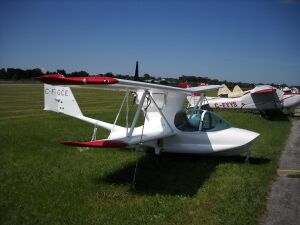Engineering:AAC SeaStar
From HandWiki
| AAC SeaStar | |
|---|---|

| |
| Role | Amphibious homebuilt aircraft |
| Manufacturer | Amphibian Airplanes of Canada |
| Status | Production completed (2012) |
| Number built | 91 (2011) |
| Variants | AAC Seastar Sealoon |

The AAC SeaStar is an amphibious biplane that was produced in kitplane form. The aircraft is built largely of composite materials and features wings that may be easily removed for transport, and a ballistic recovery system in the form of a parachute that can be deployed from the engine nacelle.[1]
AAC also marketed a Super Pétrel model in 2011.[2]
This aircraft should not be confused with another composite-built small flying boat with the same name, the SeaStar Aircraft SeaStar.
Specifications (SeaStar)
Data from Kitplanes[1]
General characteristics
- Crew: one
- Capacity: one passenger
- Length: 21 ft 4 in (6.50 m)
- Wingspan: 27 ft 4 in (8.33 m)
- Height: 7 ft 6 in (2.29 m)
- Wing area: 177.6 sq ft (16.50 m2)
- Empty weight: 704 lb (319 kg)
- Gross weight: 1,320 lb (599 kg)
- Fuel capacity: 19 U.S. gallons (72 L; 16 imp gal)
- Powerplant: 1 × Rotax 912 four cylinder, horizontally opposed four stroke aircraft engine, 80 hp (60 kW)
- Propellers: 3-bladed ground adjustable
Performance
- Maximum speed: 102 mph (164 km/h, 89 kn)
- Cruise speed: 85 mph (137 km/h, 74 kn)
- Stall speed: 40 mph (64 km/h, 35 kn)
- Range: 425 mi (684 km, 369 nmi)
- Service ceiling: 12,000 ft (3,700 m)
- Rate of climb: 800 ft/min (4.1 m/s)
- Wing loading: 7.43 lb/sq ft (36.3 kg/m2)
See also
Related development
Aircraft of comparable role, configuration and era
References
- ↑ 1.0 1.1 Downey, Julia: 1999 Kit Aircraft Directory, Kitplanes, Volume 15, Number 12, December 1998, page 30. Primedia Publications. ISSN 0891-1851
- ↑ Vandermeullen, Richard: 2011 Kit Aircraft Buyer's Guide, Kitplanes, Volume 28, Number 12, December 2011, page 43. Belvoir Publications. ISSN 0891-1851
 |

